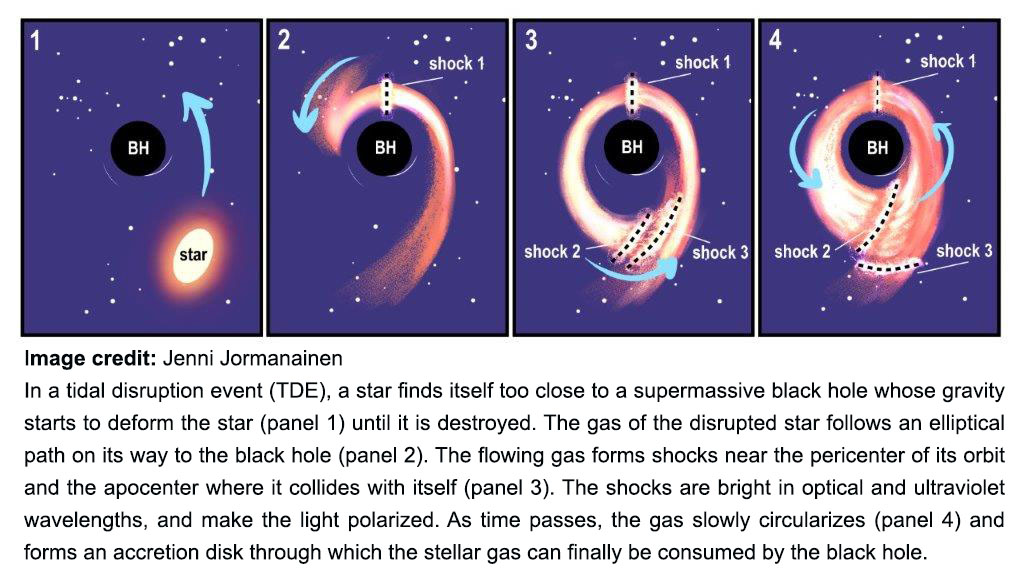All Science News

Polarized light helps scientists understand what follows a sudden star death
The Universe is a violent place, where even a star’s life can be cut short. That happens when it finds itself in a “bad” neighbourhood, and specifically the neighbourhood of a supemassive black hole. These black holes have millions to billions the mass of the Sun and reside in the centers of typically quiet galaxies. As the star moves near the black hole, it starts to experience its ever increasing gravity, until that gravity becomes more powerful than the forces that keep the star together. The star will then be destroyed or disrupted, as it is often called, and its gas will be partially consumed by the black hole.
These “star murders” are called Tidal Disruptions Events (TDE) and are very interesting and energetic phenomena. After the death of the star, its gas will form an accretion disk on its way to the black hole. That results in an outburst that can be seen typically in optical, ultraviolet, and X-rays, but sometimes even in radio wavelengths and gamma-rays as well. Until recently there have been only few TDEs known. Not because they are very rare, but because not a lot of experiments capable of detecting them existed. In the recent years that has changed, giving scientists the necessary tools to start to understand how matter behaves very near a black hole.
Interestingly, that has led to more questions than answers. Observations from large scale experiments with optical telescopes has revealed that a large number of these TDEs does not produce X-rays. This contradicts our basic understanding of TDEs, which suggests the quick formation of an X-ray bright accretion disk as soon as the star is murdered.
Polarization of the light coming from these events might hold the key to solve this mystery. An international team of astronomers that includes members from the Institute of Astrophysics (IA) and the University of Crete, published a study in the journal Science suggesting instead that for the X-ray faint TDEs, the formation of the accretion disk is not fast, but rather tidal shocks form as the gas from the star flows around the black hole. Those shocks are bright in optical and ultraviolet light making up what our telescopes observe as the outburst. The X-ray bright accretion disk comes later.
“Polarization of light can provide unique information about the underlying processes in astrophysical systems” said Yannis Liodakis, lead author of the study, astronomer at FINCA and alumnus of the University of Crete. “The polarized light we measured from the TDE could only be explained if we are looking at these tidal shocks.”
The team received a public alert in late 2020 from the satellite called Gaia of a TDE in a nearby galaxy designated as AT2020mot. AT2020mot was then observed in a wide range of wavelengths in radio, optical, ultraviolet, and X-rays with many different telescopes.

Particularly important were the observations in optical polarization conducted at the Skinakas observatory using the unique RoboPol polarimeter, that made this discovery possible. “The RoboPol polarimeter at the Skinakas observatory has really been the cornerstone of our studies trying to understand supermassive black holes”, said Nikos Mandarakas, PhD student at IA and the University of Crete who led the polarization observations and analysis with RoboPol.
Scientists found that the optical light coming from AT2020mot, was highly polarized, and was varying with time. Despite many attempts, none of the radio or X-ray telescopes were able to detect the event before, during, or even months after the peak of the outburst. “We often observe jets from supermassive black holes that are as polarized as AT2020mot was, but this time there was no evidence for a jet” said Dmitry Blinov, senior postdoctoral scientist at IA.
Putting all this information together, and after comparing their observations to theoretical models, the team of astronomers realized that the data most closely matched a scenario when the stream of stellar gas collides with itself and forms shocks near the pericenter and apocenter of its orbit around the black hole. The shocks then amplify and order the magnetic field in the stellar stream that will naturally lead to highly polarized light. The level of the optical polarization was too high to be explained by most models, and the fact that it was changing over time made it even harder. “We looked at the different models, but only the tidal shock model could explain our observations” said Kostas Kouroumpatzakis, at the time of the observations a PhD student at the University of Crete, now a postdoctoral fellow at the Astronomical Institute of the Czech Academy of Sciences.
Scientists will continue to observe the polarized light coming from TDEs, and may soon discover more about what happens after a star is murdered.
Link to the publication: https://www.science.org/doi/10.1126/science.abj9570








